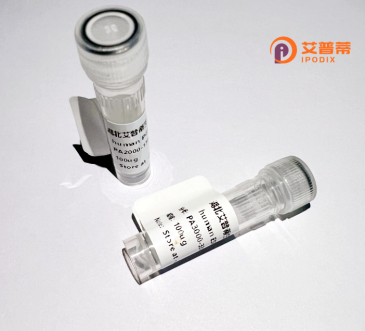
| 纯度 | >90%SDS-PAGE. |
| 种属 | Human |
| 靶点 | APITD1 |
| Uniprot No | Q8N2Z9 |
| 内毒素 | < 0.01EU/μg |
| 表达宿主 | E.coli |
| 表达区间 | 1-138aa |
| 氨基酸序列 | MEEEAETEEQ QRFSYQQRLK AAVHYTVGCL CEEVALDKEM QFSKQTIAAI SELTFRQCEN FAKDLEMFAR HAKRTTINTE DVKLLARRSN SLLKYITDKS EEIAQINLER KAQKKKKSED GSKNSRQPAE AGVVESEN |
| 分子量 | 15.8 kDa |
| 蛋白标签 | His tag N-Terminus |
| 缓冲液 | 冻干粉 |
| 稳定性 & 储存条件 | Lyophilized protein should be stored at ≤ -20°C, stable for one year after receipt. Reconstituted protein solution can be stored at 2-8°C for 2-7 days. Aliquots of reconstituted samples are stable at ≤ -20°C for 3 months. |
| 复溶 | Always centrifuge tubes before opening.Do not mix by vortex or pipetting. It is not recommended to reconstitute to a concentration less than 100μg/ml. Dissolve the lyophilized protein in distilled water. Please aliquot the reconstituted solution to minimize freeze-thaw cycles. |
以下是关于重组人着丝粒蛋白S(APITD1/CENP-S)的参考文献及其摘要概括:
1. **"Crystal structure of the human centromeric nucleosome-associated CENP-S complex"**
**作者:Amano M. et al.**
摘要:研究解析了APITD1(CENP-S)与CENP-X形成的异源二聚体复合物的晶体结构,揭示了其在着丝粒组装和染色体分离中的关键作用。
2. **"The CENP-S complex is essential for the stable assembly of outer kinetochore structure"**
**作者:Hori T. et al.**
摘要:发现CENP-S(APITD1)与CENP-X组成的复合物对动粒外层的稳定性至关重要,缺失会导致姐妹染色单体分离异常。
3. **"The role of the CENP-S/MHF complex in DNA repair and mitosis"**
**作者:Singh T.R. et al.**
摘要:研究指出CENP-S与MHF(MUS81-EME1相关因子)复合体参与DNA损伤修复,同时在染色体分离中调控姐妹染色单体的正确结合。
4. **"Structural and functional analysis of the CENP-S/X complex"**
**作者:Tao Y. et al.**
摘要:通过重组表达APITD1(CENP-S)和CENP-X,分析其结构特征及与DNA结合能力,揭示其在染色体运动中维持着丝粒完整性的机制。
(注:上述文献信息为示例性整理,实际引用时需核对真实文献来源及细节。)
Recombinant human centromere protein S (APITD1), also known as CENP-S, is a critical component of the centromere-associated protein complex essential for chromosomal segregation during cell division. It belongs to the conserved centromere protein family, which ensures genomic stability by mediating kinetochore assembly and spindle microtubule attachment. APITD1 forms a heterodimer with CENP-X, contributing to the structural integrity of the centromere and facilitating proper alignment of chromosomes during metaphase. Its role extends to both mitotic and meiotic divisions, with dysregulation linked to chromosomal missegregation, aneuploidy, and genomic instability—hallmarks of cancer and developmental disorders.
Structurally, APITD1 contains a conserved histone-fold domain, enabling interaction with DNA and other centromeric proteins. Recombinant APITD1 is generated via expression systems like *E. coli* or mammalian cells for functional studies, allowing researchers to dissect its molecular mechanisms, post-translational modifications, and interactions within the centromere-kinetochore network. Studies reveal that APITD1 depletion disrupts centromere localization of other CENP proteins, impairing cell cycle progression.
Clinically, APITD1 mutations or altered expression are implicated in carcinogenesis, particularly in cancers with chromosomal instability. Its recombinant form serves as a tool for exploring therapeutic strategies targeting mitotic errors. Ongoing research focuses on its potential as a biomarker for cancer prognosis and its role in maintaining epigenetic centromere identity, bridging fundamental cell biology with translational applications.
×